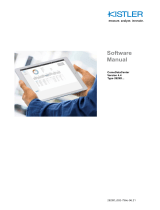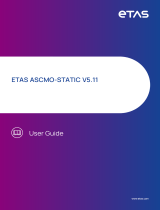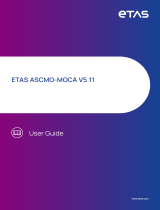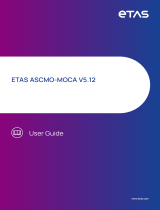Page is loading ...

Instruction
Manual
STASA QC,
Operating Point
Navigator
Type 2820A...
2820A_002-569e-04.15

Instruction
Manual
STASA QC,
Operating Point
Navigator
Type 2820A...
2820A_002-569e-04.15


Preface
Thank you for choosing a Kistler quality product charac-
terized by technical innovation, precision and long life.
Information in this document is subject to change without
notice. Kistler reserves the right to change or improve its
products and make changes in the content without obli-
getion to notify any person or organization of such
changes or improvements.
©2012 … 2015 Kistler Group. All rights reserved. Except
as expressly provided herein, no part of this manual may
be reproduced for any purpose without the express prior
written consent of Kistler Group.
Kistler Group
Eulachstrasse 22
8408 Winterthur
Switzerland
Tel. +41 52 224 11 11
Fax +41 52 224 14 14
info@kistler.com
www.kistler.com
2820A_002-569e-04.15 Page 1

Contents
1. Introduction .................................................................................................................................. 3
1.1 STASA QC .......................................................................................................................... 3
1.2 Operating Point Optimization .............................................................................................. 3
2. Installing Program ....................................................................................................................... 5
3. Creating, Saving and Loading Projects .................................................................................... 7
3.1 Creating Project .................................................................................................................. 7
3.2 Saving Project Status .......................................................................................................... 8
3.3 Loading Existing Project ...................................................................................................... 8
4. Defining Project, Machine Parameters and Sensors ............................................................... 9
4.1 "General information" View ................................................................................................. 9
4.2 "Machine parameters" View .............................................................................................. 10
5. Defining Quality Features ......................................................................................................... 12
6. Database ..................................................................................................................................... 15
6.1 Setup Stage....................................................................................................................... 15
6.2 "Design of Experiments (DoE)" View ................................................................................ 16
6.3 "Quality data" View ............................................................................................................ 17
6.4 "Machine settings optimization" View ............................................................................... 20
6.5 Determining Optimal Operating Point ............................................................................... 20
6.6 "Estimated effects of machine parameters" View ............................................................. 23
6.7 "Model values and measured values" View ...................................................................... 25
6.8 "Model statistics" View ...................................................................................................... 25
6.9 "Estimated process capability" View ................................................................................. 27
6.10 "Cycle time costs" view ..................................................................................................... 29
7. Practical example: Creating Project and Defining Machine Parameters and Quality
Features ...................................................................................................................................... 30
8. Practical example: Entering Data of Setup Stage .................................................................. 34
9. Practical example: Optimizing Operating Point ..................................................................... 39
10. List of Figures and Tables ........................................................................................................ 44
Total number of pages 44
Page 2 2820A_002-569e-04.15

Introduction
1. Introduction
Please take the time to thoroughly read this instruction
manual. It will help you with the installation, maintenance,
and use of this product.
To the extent permitted by law Kistler does not accept
any liability if this instruction manual is not followed or
products other than those listed under Accessories are
used.
Kistler offers a wide range of products for use in mea-
suring technology:
Piezoelectric sensors for measuring force, torque,
strain, pressure, acceleration, shock, vibration and
acoustic emission
Strain gage sensor systems for measuring force and
torque
Piezoresistive pressure sensors and transmitters
Signal conditioners, indicators and calibrators
Electronic control and monitoring systems as well as
software for specific measurement applications
Data transmission modules (telemetry)
Kistler also develops and produces measuring solutions
for the engines, vehicles, manufacturing, plastics and
biomechanics sectors.
Our product and application brochures will provide you
with an overview of our product range. Detailed data
sheets are available for almost all products.
If you need additional help beyond what can be found
either online or in this manual, please contact Kistler's
extensive support organization.
1.1 STASA QC
STASA QC is a software package used for operating
point optimization and online quality forecasting with
integral process monitoring. The program does not
require the user to have any expert knowledge of the
mathematical background of the techniques used.
1.2 Operating Point Optimization
This involves determining the machine settings that allow
the target values of the quality features to be achieved as
effectively as possible, while keeping the process as
stable as possible. STASA QC's approach is based on
2820A_002-569e-04.15 Page 3

STASA QC, Operating Point Navigator Type 2820A...
modeling. This means that, with the aid of data (machine
settings and measured quality features) determined in the
process setup stage with statistical design of experiments
(DoE), the relationship between these settings and
features is "learned", and a simulation model auto-
matically produced for each feature. These models can
then be used to enable the user to test the effect of
changes in the machine setting on the quality features,
without having to test this directly in an experiment on the
machine. STASA QC is also able to use an integral
optimization algorithm to determine the optimal operating
point at which the target values of the quality features
can be best achieved.
The following data is needed for operating point optimi-
zation:
Machine settings and their values in the statistical
DoE
Values of the quality features with which the parts
were produced on the basis of the DoE in the setup
stage
Operating point optimization can be performed complete-
ly offline to avoid any need to match interfaces specific to
the machine.
This manual is divided into two parts. The first (Sections
2 to 6) is a general description of the program functions
of STASA QC. The second (Sections 7 to 9) goes
through the optimization process step by step for a
particular example.
Page 4 2820A_002-569e-04.15

Installing Program
2. Installing Program
STASA QC is installed by running setup.exe, which is on
the CD-ROM. The installation process is menu driven.
The program is protected by a dongle against
unauthorized duplication. The included dongle must be
connected to the USB interface of the computer on which
STASA QC is run. The MATRIX dongle software needed
to use the dongle is also installed during the installation
of STASA QC.
The software must be installed with Administrator rights,
otherwise the driver for the dongle is not loaded when
Windows starts.
Note on USB dongle
If the USB dongle is inserted into a free USB slot for
the first time, the Plug&Play manager starts from
Windows and installs the associated driver. If the
driver is not found automatically, it must be installed
manually:
Windows XP, Vista and 7: the dongle driver is
installed via the program "MatrixLockDriver
Setup.exe" in the sub-directory "USB-Dongle
Treiber" on the CD-ROM.
Windows 2003 and Windows 8: The dongle driver is
installed via the Windows Plug&Play manager. The
associated drivers are located in the sub-directory
"USB-Dongle Treiber\Windows 2003 und 8" on the
CD-ROM.
The dongle is only detected in the USB port in which
it was installed.
2820A_002-569e-04.15 Page 5

STASA QC, Operating Point Navigator Type 2820A...
Note on licensing
To activate the dongle, the license number must be
entered in STASA QC. This is done either when the
program starts, by choosing "Enter License Key" in the
starting dialog box, or by choosing Edit > License Key
from the menu.
Note on language settings
To change language you have to select one of the
available languages in the corresponding list box or go
to menu bar and select Edit > settings..
Note on user managementt
The user management can be activated in the menu
Edit -> User management. If user management is
activate each user has to authenticate by entering user
name and password when starting STASA QC. This
ensures that only authorized persons can use STASA
QC and make changes to project data.
Users and passwords can be added, modified and
deleted in the same menu.
By default the administrator user has the name “admin”
and password “admin”.
Page 6 2820A_002-569e-04.15

Creating, Saving and Loading Projects
3. Creating, Saving and Loading Projects
Master data, optimization results and quality forecasts
are managed in STASA QC in the form of projects. This
means that, for each produced product for which the
machine parameters are to be optimized and, in a further
step, an online quality forecast made, a project is
created. A clear overview of the management of
optimization and forecasting results is therefore
maintained, even if STASA QC is being used for several
optimization tasks.
3.1 Creating Project
There are two ways of creating a new project:
Immediately after STASA QC starts, a dialog box is
displayed asking whether a new project is to be
created, an existing one opened or the program
closed. Choosing Create New Project opens another
dialog box, which prompts you to enter a name for the
project.
A new project can also be created by choosing
Project file > New from the menu. In this case as
well, a dialog box prompts you to enter the name of
the new project.
You use the project name to specify the folder in which
the project files (STASA QC files, optimization results,
measurement curves, online forecasting results, etc.) are
saved. These project files are then in a subfolder of
STASA QC named after the project name (generally
C:\Program Files\STASA\STASA-QC\Projects\). A unique
project name must therefore be chosen. It is not possible
to create another project with the same name.
2820A_002-569e-04.15 Page 7

STASA QC, Operating Point Navigator Type 2820A...
3.2 Saving Project Status
The project can be saved by choosing Project file >
Save or Project file > Save as from the menu. This
saves the current status of the project.
The project is usually saved under the same name as
when it was created. Project file > Save as can be used
to specify an alternative name for the project file. This is
useful if, for example, different strategies are to be tested
in the DoE, or several intermediate stages are to be
saved.
3.3 Loading Existing Project
An existing project file can be loaded with the dialog box
immediately after the program is started, or by choosing
Project file > Load from the menu.
Page 8 2820A_002-569e-04.15

Defining Project, Machine Parameters and Sensors
4. Defining Project, Machine Parameters and Sensors
Choosing the Project view offers the option of three sub-
views General information, Machine parameters and
Sensors), which are used to enter information about the
project.
Fig. 1: Definition of project
4.1 "General information" View
In this view, the master data for the project, such as
project number, user, customer and various items of
product data are entered. Comments on the project or the
product (part) can also be saved in the project file and a
link to a photo (JPG, GIF or BMP) provided.
A thumbnail of the photo is shown in the logo banner at
the top and can be displayed in a separate window at any
time by double-clicking.
The following information must be entered:
Project name, Project number, Article name, Mold ID,
and Number of cavities.
2820A_002-569e-04.15 Page 9

STASA QC, Operating Point Navigator Type 2820A...
4.2 "Machine parameters" View
All of the available machine parameters and process
parameters are listed in this view. The following functions
are available. They can be activated with the button of
the same name or by choosing Definitions > Machine
parameters from the menu:
Fig. 2: Adding or editing a machine parameter
Add parameter
This opens a dialog box for defining a new machine
parameter (Fig. 2).
Edit parameter
This is used to change the data, e.g. the Smallest value
of a machine parameter that has already been defined.
The machine parameter currently chosen from the list by
clicking with your mouse is altered.
Delete parameter
This is used to delete the machine parameter currently
chosen from the list by clicking with your mouse.
Import
This is used to read a complete list of machine
parameters from a CSV text file. The CSV file must be
structured according to a fixed convention (see
"Exporting" section and Table 1). To then enable re-
importation into STASA QC of a file edited in Microsoft
Excel, this file must be saved in Excel as a CSV file. In
Excel this is achieved by choosing File > Save as from
the menu and selecting the file type CSV (delimiter-
separated) (*.csv).
Page 10 2820A_002-569e-04.15

Defining Project, Machine Parameters and Sensors
When reading CSV files, STASA QC can distinguish
whether "." or "," is used in the text file as decimal
separator. Mixed use of the decimal separators is
also possible. To ensure correct reading of files
edited beforehand with Excel, the formatting of the
Excel cells must not, however, contain any thousands
separators.
Export
This exports the defined machine parameters to a text
file. The machine parameters defined by means of Add
parameter are saved in a CSV file. The user is prompted
to enter a filename (extension: .csv). Unless specified
otherwise, this file is saved in the project folder. This is
generally under "My Documents \STASAQC\Project
name", or, in Windows® Vista or Windows® 7 under
"Documents\STASA QC\".
To edit an exported parameters file in Microsoft Excel, for
example in order to define the machine parameters
outside STASA QC (See Section 6 Database), this file
can be opened in Excel by double-clicking, or opened in
the dialog box by choosing Text files (*.prn *.txt *.csv).
To define a DoE outside STASA QC in Excel with this
file, the associated value from the DoE can be entered in
the columns of the corresponding parameter. This
involves the different DoE settings being entered line by
line with the associated sequential number. The "Number
of parts" column contains the number of parts to be
produced in the associated experiment. A * must be
entered in the first column. The following table shows an
example as a guide:
Table 1: Import/Export data format for machine
parameters
M2.0
DEC,
Name
T-Mass
T-Wkz-DS
T-Wkz-AS
t-On
*
*
Abbreviation
T-Mass
T-Wkz-DS
T-Wkz-AS
t-On
*
*
Unit
°C
°C
°C
s
*
*
Max
315
90
100
1,2
*
*
Min
295
50
60
0,4
*
*
Increment
5
5
5
0,05
*
Setup
Number of parts
Value
Value
Value
Value
*
1
10
305
70
80
0,9
*
2
10
295
60
70
0,4
*
3
10
295
70
80
0,65
*
4
10
300
55
65
1,4
2820A_002-569e-04.15 Page 11

STASA QC, Operating Point Navigator Type 2820A...
5. Defining Quality Features
Choosing the Quality features view enables you to enter
these features of the part and their tolerances and target
values (Figure 3).
Fig. 3: View of quality features
The following functions are available, and can be
activated using the button of the same name or the
Quality features menu.
Add quality feature
This opens a dialog box for defining a quality feature. The
definition can distinguish between continuously
measurable features and attributive features (subjectively
evaluated features, which can be divided into classes
(e.g. grades)) by choosing the type (Figure 4).
In defining a quality feature, the cavity for which the
feature is defined must be specified. For a quality feature
that is not to be defined specifically for a cavity, e.g. the
cycle time, "0" is entered instead of the number of the
cavity.
Checking "Copy definitions for all cavities" generates the
quality feature for all cavities with the same data for Unit,
Target value and Tolerances, and the corresponding
Page 12 2820A_002-569e-04.15

Defining Quality Features
attributes for attributive quality features. The saves
manual definition of the quality features for each cavity of
multicavity molds.
It is advisable to choose unique names for the quality
features of each cavity.
If "Copy definitions for all cavities" is checked, the
chosen name is automatically given the extension
"Cav. 1", "Cav. 2", etc.
Fig. 4: Dialog box for defining a quality feature
Attributive feature:
The attributes of the feature can be entered in a text box
separated by a semicolon (without space). The last
attribute must not be followed by a semicolon, otherwise
STASA QC would expect another attribute! (For example:
very good; good; satisfactory; fair).
The following must be observed when entering the
tolerances and the target value:
Last attribute on the list which is still allowable (upper
tolerance attribute): the attribute that is positioned on the
extreme right of the list and is still allowable.
Attribute which should be reached (target attribute): the
attribute that is to function as target value (generally the
same as the best attribute).
First attribute on the list which is allowable (Lower toler-
ance attribute: the attribute that is positioned on the
extreme left of the list and is still allowable.
2820A_002-569e-04.15 Page 13

STASA QC, Operating Point Navigator Type 2820A...
Continuous feature:
The physical unit in which the quality feature is measured
must be entered here in addition to the target value and
the tolerance values.
The check box "use feature for online quality forecasting"
can be ticked to specify whether online forecasting is to
be performed for the feature and included in the quality
evaluation. Alternatively, in the list the feature can be
activated (green tick) or deactivated (red cross) by
double-clicking the colored symbol on the left of the
feature.
Edit quality feature
This is used to change the data, for example the target
value of a feature that has already been defined. The
quality feature currently selected in the list by clicking
with your mouse is altered (Fig. 3).
Remove feature
Used to remove the feature currently selected in the list
by clicking with your mouse.
Import
Used to read a complete list of quality features from a
CSV text file. The CSV file must be structured according
to a fixed convention.
Export
This is used to export the defined quality features to a
CSV text file. The features defined with Add quality
feature are saved in a CSV file.
The user is prompted to enter a filename (extension:
.csv).
Unless specified otherwise, this file is saved in the sub-
folder of quality data of the program folder of STASA QC.
This is generally:
C:\Program Files\STASA\stasaQC\Quality data\.
Q2.1
DEC,
name
length
diameter
*
*
unit
mm
mm
*
*
Cavity
1
1
*
*
type
continuous
continuous
*
*
attributes
NULL
NULL
*
*
UpperTol
58,6
12,08
*
*
TargetValue
58,55
12,06
*
*
LowerTol
58,5
12,04
signalfile
experiment-no
use?
value
value
Table 2: Import/Export data format for defining quali-
ty features
Page 14 2820A_002-569e-04.15

Database
6. Database
The Database view is used to create the database
needed for operating point optimization and creation of
the online forecasting models. This view is used to define
a DoE, on the basis of which the parts of the setup stage
(mold validation) are produced and measured. Subse-
quently, in actual production, the view can be used to
define, produce and measure samples. The Database
view is divided into two sub-views: Design of
Experiments and Quality Data.
Fig. 5: Database View – DoE
6.1 Setup Stage
In the setup stage (mold validation), on the basis of a
DoE different machine settings are used to produce
parts, whose quality features are then measured. This
data is required by STASA QC to learn the relationship
between process data, such as pressure and tempera-
ture curves or machine settings, and the quality features.
2820A_002-569e-04.15 Page 15

STASA QC, Operating Point Navigator Type 2820A...
6.2 "Design of Experiments (DoE)" View
This view is used to create the DoE. This can be entered
in the table manually or created automatically using the
Create DoE button (Figure 5).
If settings are entered in the table before the DoE is
created, by clicking the Create DoE button they are
automatically supplemented as optimally as possible to
produce a complete DoE.
The first column of the table contains the number of parts
to be produced for the particular experiment. When all of
the rows of the table have been completed with
experiment settings, one row is automatically added to
the table to enable any number of experiments to be
defined in the DoE.
Shots per setting
This button can be used to change the number of cycles
run and to be measured for each experiment (default:
10).
Import DoE
As an alternative to entering the DoE in STASA QC, an
externally edited DoE can also be imported. This must be
available as a CSV text file in the format defined in
Section 4.2.
Export DoE
This button can be used to export the DoE entered in
STASA QC to a CSV file.
Delete DoE
Deletes the entire DoE. Please take careful note that this
cannot be undone.
Send DoE to CoMo Interface
This prepares the DoE for running on a CoMo Injection
system, provided a license for online quality forecasting
has been purchased.
Get DoE from CoMo Interface
This retrieves the DoE after it has been run on a CoMo
Injection system, provided a license for online quality
forecasting has been purchased.
The created DoE is a suitable proposal for practical
experimentation based on the D-
optimal design
algorithm. In the "DoE" section of the menu Edit >
Settings
, experts can preset the number of
experiments to be performed ("Determine number of
experiments automatically" must be unchecked to
allow this, (default: 10) and the factor levels (default:
2) specified.
Page 16 2820A_002-569e-04.15

Database
6.3 "Quality data" View
This view can be used to enter in a table the quality
measurement results of the parts produced according to
the DoE (Figure 6).
Fig. 6: Quality data view
If the DoE is run with a CoMo Injection system (online
quality forecasting), the first column contains a filename
of the signal data file recorded by the sensors. These
signal files are created automatically if the experiments
documented in the DoE with STASA QC are performed
directly with a CoMo Injection system. The corresponding
files are found in the signal folder "Signaldata\DoEdata1"
of the project. Generally: C:\Program Files\STASA\
stasaQC\Projects\Project name\Signaldata\ Signaldata\
DoEdata1\.
Note: If pure operating point optimization is being carried
out, no signal files are required. The first column then
contains consecutive numbering of the produced parts or
the character „-„.
The second column specifies the number of the
experimental setting of the DoE. This numbering must
agree with that of the DoE in order to ensure the parts
are uniquely related to the machine setting of the
particular experiment.
2820A_002-569e-04.15 Page 17
/










